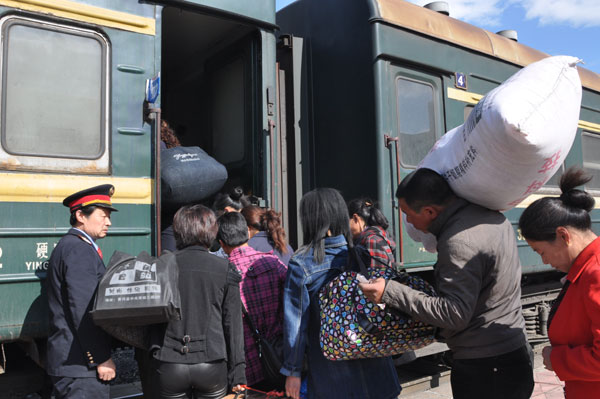Hired hands take to northeast rice fields
Updated: 2012-05-10 07:25
By Zhou Huiying in Harbin (China Daily)
|
||||||||
A special train full of migrant workers arrived on Wednesday morning at Qianjin town in the Sanjiang Plain, a major rice growing area in Northeast China's Heilongjiang province.
Wang Dongxu, 36, who rents 27 hectares of rice farmland, picked up 45 migrant workers from the train to take to his farm.
"Every year, we need about 60 workers to transplant rice seedlings. Most of them are employed from the areas outside the plain. Last year, thanks to the help of these migrant workers, rice transplanting finished at the best time and I had a good harvest," said Wang.
Given the climate in Heilongjiang, the best time for rice seedling transplantation is from May 5 to 25, which can help ensure a good harvest.
 |
|
Farmers board a train at the Harbin East Railway Station in Heilongjiang province on Tuesday, heading to the Sanjiang Plain to transplant rice seedlings. Wang Chengwang / for China Daily |
"Last year, the income from my rice farmland reached 300,000 yuan ($47,500), yielding a 100,000 yuan profit. This year, I hope the transplantation of rice seedlings will go well and we can harvest in the autumn," said Wang.
Qianjin Farm is one of the important rice farms on the Sanjiang Plain. The farm has 53,000 hectares of arable land and 52,000 hectares are used to grow rice.
Although in recent years, agricultural mechanization has greatly increased, rice seedling transplanting still relies heavily on manual labor.
As there are not enough farmhands in local areas to do the job, groups of migrant workers move to the Sanjiang Plain every year. Most of them come from the rural areas in Harbin and Suihua, in Heilongjiang, and some rural counties in neighboring Jilin province.
According to the Harbin Railway Bureau, the two rail lines opened on Sunday - one from Jiamusi, a city in Heilongjiang, to Qianjin town; the other from Harbin East Railway Station to the town - and are estimated to have transported 35,000 migrant workers as of May 13.
Since 2000, when the administration started the service, the special trains have transported 1.27 million migrant workers to and from the rice production areas in Heilongjiang.
Sha Fengxia, 45, a farmer from Fu'an village, Yushu, Jilin province, was one of the workers taking the Wednesday train to Qianjin Farm.
"In the following two weeks, we will work on the Qianjin Farm, transplanting rice seedlings," he said.
"I have come to the farm every spring since 2007. There are eight people from our village on this train this year, and we will do the same work. Everyone can get 300 yuan per day, and we can make 5,000 to 6,000 yuan by the time we go home. That's much more than I can earn at home," said Sha.
Because the climate is different, spring sowing can be finished earlier in Jilin than in Heilongjiang. So many farmers come to Heilongjiang every year to make some extra income.
"Since the late 1980s, farmers from other areas have been working on the Sanjiang Plain during the rice transplanting period. Since 2000, the number has continued to grow steadily," said Hou Lihong, director of the labor transfer office of the Heilongjiang provincial rural affairs commission.
The trains pass several of the major rice farms. Besides the Qianjin Farm, there are Hulin Farm, Jiansanjiang Farm, and Dongfanghong Farm," said Ma Cheng, director of Harbin East Railway Station's passenger transport section.
zhouhuiying@chinadaily.com.cn

 Relief reaches isolated village
Relief reaches isolated village
 Rainfall poses new threats to quake-hit region
Rainfall poses new threats to quake-hit region
 Funerals begin for Boston bombing victims
Funerals begin for Boston bombing victims
 Quake takeaway from China's Air Force
Quake takeaway from China's Air Force
 Obama celebrates young inventors at science fair
Obama celebrates young inventors at science fair
 Earth Day marked around the world
Earth Day marked around the world
 Volunteer team helping students find sense of normalcy
Volunteer team helping students find sense of normalcy
 Ethnic groups quick to join rescue efforts
Ethnic groups quick to join rescue efforts
Most Viewed
Editor's Picks

|

|

|

|

|

|
Today's Top News
Health new priority for quake zone
Xi meets US top military officer
Japan's boats driven out of Diaoyu
China mulls online shopping legislation
Bird flu death toll rises to 22
Putin appoints new ambassador to China
Japanese ships blocked from Diaoyu Islands
Inspired by Guan, more Chinese pick up golf
US Weekly

|

|






